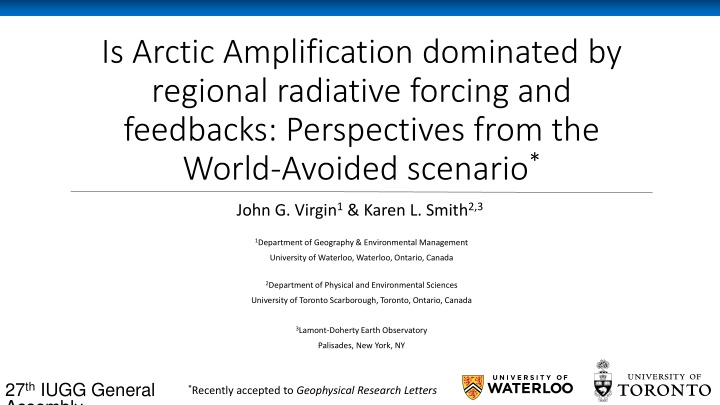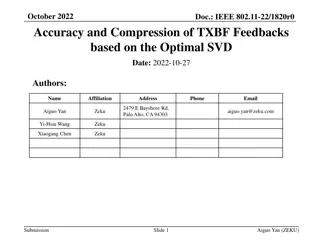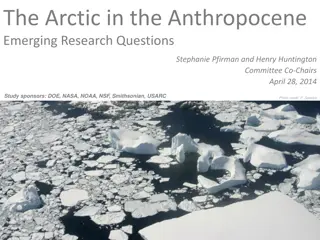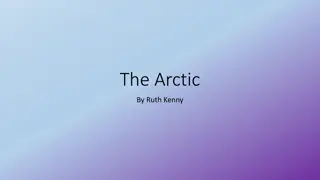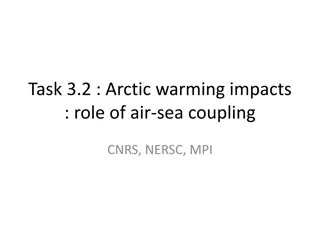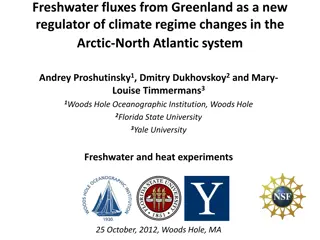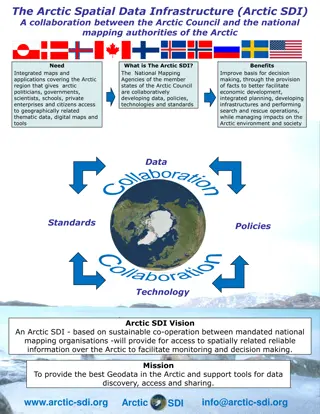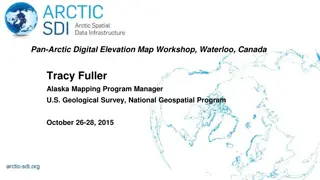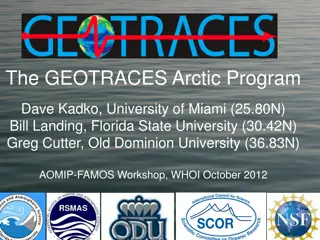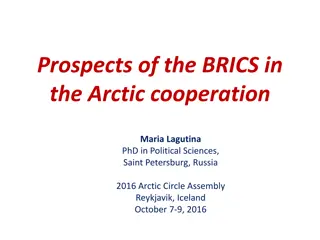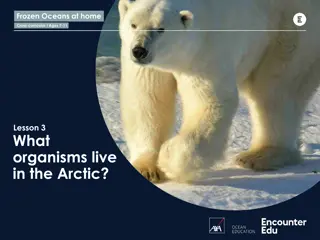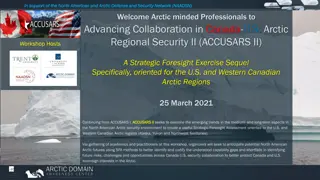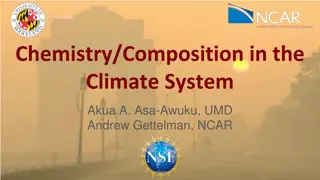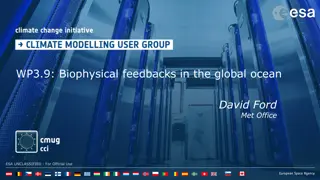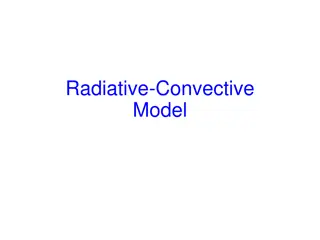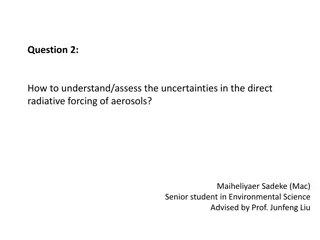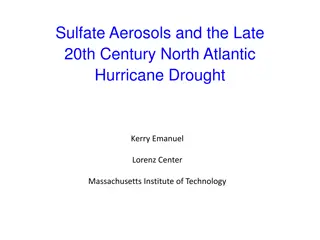Regional Radiative Forcing and Feedbacks in Arctic Amplification
Arctic Amplification (AA) is explored in the context of regional radiative forcing and feedbacks in the study by Virgin and Smith (2019). The research investigates the dominance of these factors in the meridional variations of AA, highlighting the contributions of different feedback mechanisms during winter and summer. The role of poleward energy transport and how AA is assessed in response to radiative forcing are also discussed. Model integrations under Representative Concentration Pathway 4.5 provide insights into future scenarios. Overall, the study offers perspectives on the complex interactions driving Arctic climate change.
Download Presentation

Please find below an Image/Link to download the presentation.
The content on the website is provided AS IS for your information and personal use only. It may not be sold, licensed, or shared on other websites without obtaining consent from the author.If you encounter any issues during the download, it is possible that the publisher has removed the file from their server.
You are allowed to download the files provided on this website for personal or commercial use, subject to the condition that they are used lawfully. All files are the property of their respective owners.
The content on the website is provided AS IS for your information and personal use only. It may not be sold, licensed, or shared on other websites without obtaining consent from the author.
E N D
Presentation Transcript
Is Arctic Amplification dominated by regional radiative forcing and feedbacks: Perspectives from the World-Avoided scenario* John G. Virgin1& Karen L. Smith2,3 1Department of Geography & Environmental Management University of Waterloo, Waterloo, Ontario, Canada 2Department of Physical and Environmental Sciences University of Toronto Scarborough, Toronto, Ontario, Canada 3Lamont-Doherty Earth Observatory Palisades, New York, NY 27th IUGG General Assembly *Recently accepted to Geophysical Research Letters
Introduction Methods Results Limitations Conclusions - Acknowledgments Arctic Amplification Typically associated with meridionally varying radiative feedbacks The Planck and lapse rate feedbacks dominate in the winter The surface albedo feedback dominates in the summer Pithan & Mauritsen (2014) Virgin & Smith (2019): Is AA dominated by regional radiative forcing and 27th IUGG General
Introduction Methods Results Limitations Conclusions - Acknowledgments Poleward Energy Transport The role of poleward energy flux into in contributing to AA is not as well understood Zelinka & Hartmann (2012) Hwang, Frierson, and Kay (2011) Virgin & Smith (2019): Is AA dominated by regional radiative forcing and 27th IUGG General
Introduction Methods Results Limitations Conclusions - Acknowledgments Radiative Forcing AA is typically evaluated in response to a radiative forcing that is either spatially homogenous or highly idealistic Stuecker et al. (2018) Virgin & Smith (2019): Is AA dominated by regional radiative forcing and 27th IUGG General
Introduction Methods Results Limitations Conclusions - Acknowledgments Model Integrations Representative Concentration Pathway 4.5 (RCP45) Greenhouse gas concentrations rise to 538ppm and stabilize after 2100 The World Avoided (WAVD) ODS emissions set to grow at 3.5% per year from 1985 onwards Virgin & Smith (2019): Is AA dominated by regional radiative forcing and 27th IUGG General
Introduction Methods Results Limitations Conclusions - Acknowledgments The Whole Atmosphere Community Climate Model (WACCM4) High-top Chemistry-Climate Model Similar physical parametrizations to the low-top CAM4 Chemistry component that couples chemical, radiative, and dynamical processes in the stratosphere 66 vertical levels resolving up into the lower thermosphere WACCM4 CLM CPL POP CICE Virgin & Smith (2019): Is AA dominated by regional radiative forcing and 27th IUGG General
Introduction Methods Results Limitations Conclusions - Acknowledgments The Arctic Energy Budget ????= ? ??+ ?????+ ? + ???? Virgin & Smith (2019): Is AA dominated by regional radiative forcing and 27th IUGG General
Introduction Methods Results Limitations Conclusions - Acknowledgments The Arctic Energy Budget ????= ? ??+ ?????+ ? + ???? ????= change in net radiative flux at the TOA Virgin & Smith (2019): Is AA dominated by regional radiative forcing and 27th IUGG General
Introduction Methods Results Limitations Conclusions - Acknowledgments The Arctic Energy Budget ????= ? ??+ ?????+ ? + ???? ????= change in net radiative flux at the TOA ? = the linear sum of all radiative feedbacks (Planck, Albedo, etc.) Virgin & Smith (2019): Is AA dominated by regional radiative forcing and 27th IUGG General
Introduction Methods Results Limitations Conclusions - Acknowledgments The Arctic Energy Budget ????= ? ??+ ?????+ ? + ???? ????= change in net radiative flux at the TOA ? = the linear sum of all radiative feedbacks (Planck, Albedo, etc.) ?? = The change in Arctic mean surface temperature Virgin & Smith (2019): Is AA dominated by regional radiative forcing and 27th IUGG General
Introduction Methods Results Limitations Conclusions - Acknowledgments The Arctic Energy Budget ????= ? ??+ ?????+ ? + ???? ????= change in net radiative flux at the TOA ? = the linear sum of all radiative feedbacks (Planck, Albedo, etc.) ?? = The change in Arctic mean surface temperature ?????= The stratosphere-adjusted radiative forcing Virgin & Smith (2019): Is AA dominated by regional radiative forcing and 27th IUGG General
Introduction Methods Results Limitations Conclusions - Acknowledgments The Arctic Energy Budget ????= ? ??+ ?????+ ? + ???? ????= change in net radiative flux at the TOA ? = the linear sum of all radiative feedbacks (Planck, Albedo, etc.) ?? = The change in Arctic mean surface temperature ?????= The stratosphere-adjusted radiative forcing ?= The horizontal flux convergence into the Arctic Virgin & Smith (2019): Is AA dominated by regional radiative forcing and 27th IUGG General
Introduction Methods Results Limitations Conclusions - Acknowledgments The Arctic Energy Budget ????= ? ??+ ?????+ ? + ???? ????= change in net radiative flux at the TOA ? = the linear sum of all radiative feedbacks (Planck, Albedo, etc.) ?? = The change in Arctic mean surface temperature ?????= The stratosphere-adjusted radiative forcing ?= The horizontal flux convergence into the Arctic ????= The change in ocean heat content Virgin & Smith (2019): Is AA dominated by regional radiative forcing and 27th IUGG General
Introduction Methods Results Limitations Conclusions - Acknowledgments Radiative Forcing The global mean net RF in the WAVD is 3.76 Wm-2 Combined result of both GHG s and ODS s Stratospheric ozone loss results in a negative (-0.19 Wm-2) net Arctic RF in the WAVD Long-wave = -0.48 Wm-2 Short-wave = 0.29 Wm-2 Virgin & Smith (2019): Is AA dominated by regional radiative forcing and 27th IUGG General
Introduction Methods Results Limitations Conclusions - Acknowledgments Arctic Energy Budget Virgin & Smith (2019): Is AA dominated by regional radiative forcing and 27th IUGG General
Introduction Methods Results Limitations Conclusions - Acknowledgments Arctic Energy Budget Statistically Significant differences between scenarios for: LW Cloud feedback PET by the atmosphere Virgin & Smith (2019): Is AA dominated by regional radiative forcing and 27th IUGG General
Introduction Methods Results Limitations Conclusions - Acknowledgments Contributions of Uncertainty The stratosphere-adjusted radiative forcing, as opposed to the effective radiative forcing Cloud feedback quantification using the adjusted cloud radiative effect Virgin & Smith (2019): Is AA dominated by regional radiative forcing and 27th IUGG General
Introduction Methods Results Limitations Conclusions - Acknowledgments Concluding Remarks Despite a negative net RF in the Arctic in the WAVD from ozone loss, AA still occurred at a similar magnitude to RCP45 Virgin & Smith (2019): Is AA dominated by regional radiative forcing and 27th IUGG General
Introduction Methods Results Limitations Conclusions - Acknowledgments Concluding Remarks Despite a negative net RF in the Arctic in the WAVD from ozone loss, AA still occurred at a similar magnitude to RCP45 In the WAVD, AA is maintained by greater energy flux convergence into the Arctic by the atmosphere, and a stronger long-wave cloud feedback Virgin & Smith (2019): Is AA dominated by regional radiative forcing and 27th IUGG General
Introduction Methods Results Limitations Conclusions - Acknowledgments Concluding Remarks Despite a negative net RF in the Arctic in the WAVD from ozone loss, AA still occurred at a similar magnitude to RCP45 In the WAVD, AA is maintained by greater energy flux convergence into the Arctic by the atmosphere, and a stronger long-wave cloud feedback Arctic Amplification under the presence of a negative radiative forcing highlights that its key drivers (forcing, feedbacks, or poleward energy transport) may depend on the context of the evolving climate state & experiment design Virgin & Smith (2019): Is AA dominated by regional radiative forcing and 27th IUGG General
Introduction Methods Results Limitations Conclusions - Acknowledgments FIN Virgin & Smith (2019): Is AA dominated by regional radiative forcing and 27th IUGG General
Introduction Methods Results Limitations Conclusions - Acknowledgments This work has been supported by: This work has been supported by: Article Full Citation: Article Full Citation: Virgin, J. G., & Smith, K. L. (2019). Is Arctic Amplification dominated by regional radiative forcing and feedbacks: Perspectives from the World-Avoided scenario. Geophysical Research Letters, 46(11). https://doi.org/10.1029/2019GL082320 Department of Physical & Environmental Sciences, University of Toronto Scarborough References: References: NSF Division of Polar Programs award: PLR-1603350 Hwang, Y.-T., Frierson, D. M., & Kay, J. E. (2011). Coupling between arctic feedbacks and changes in poleward energy transport. Geophysical Research Letters, 38(17). Data Access: Data Access: Pithan, F., & Mauritsen, T. (2014). Arctic amplification dominated by temperature feedbacks in contemporary climate models. Nature Geoscience, 7 (3), 181. Post-Processed Data files: https://arcticdata.io/catalog/view/doi:10.1873 9/A2416SZ8Z Stuecker, M. F., Bitz, C. M., Armour, K. C., Proistosescu, C., Kang, S. M., Xie, S.-P., . . . others (2018). Polar amplification dominated by local forcing and feedbacks. Nature Climate Change, 8(12), 1076 Plotting Scripts: https://github.com/JohnVirgin/Perspectives- From-World-Avoided. Zelinka, M. D., & Hartmann, D. L. (2012). Climate feedbacks and their implications for poleward energy flux changes in a warming climate. Journal of Climate, 25 (2), 608-624. Virgin & Smith (2019): Is AA dominated by regional radiative forcing and 27th IUGG General
